Getting Started With a Single A140
Reading time ~6 minutes
The simplest way to use an A140 is to attach a keyboard, and type the URL for the Amino control page hosted by Cinegy Route. With the keyboard attached, it is possible to press the F10 key to access the URL entry dialog which appears along the top-edge of the screen. Any reachable web-address can be entered here to test the Amino machine and the network behavior.
|
Note
|
Amino USB keyboards are not hot-pluggable; you will need to restart the Amino for the keyboard to be detected. With a keyboard attached, you can also use Alt-M and ALT+P to access system menus – please see Amino configuration guides for more information. |
To ask the Amino to attach to the Cinegy Route, you can enter the following URL (substituting the real address of the Cinegy Route Directory Service server):
http://<routeservernameorip>:9996/control/amino/amino.html
|
Note
|
The same URL can be tested inside a desktop browser, to verify the network is accessible and working. |
By default, a channel pop-up menu will appear, probably indicating that "Not Yet Routed". This pop-up will show you the virtual destination that the box is attempting to map to – by default, this is a virtual destination called "Amino1" inside the "Amino" folder.

Once this virtual destination is created inside Cinegy Route Manager, you can map a stream or channel to the virtual destination. As soon as this connection is established, the Amino should switch to the described channel (the Amino reboot may be required if the virtual destination was just created):

The above strap shows the virtual destination now mapped to a channel within a multi-program transport stream, and the Amino should be playing the specified channel. After approximately 10 seconds, the strap should disappear.
When any changes are made to the virtual destination, the Amino should change within approximately 1 second to the new destination, and the pop-up strap will temporarily re-appear to indicate the changed location again.
|
Note
|
Please note, Amino A140 units do not support all profiles and bitrates possible with MPEG2 and H.264 – details of what is supported can be found on the technical specification sheet for the Amino unit. For higher-capability decoding of formats such as 422 video, we recommend using Cinegy Encode software as a decoder. |
Once you are comfortable that the Amino unit is working correctly with the manually entered URL, you can choose to set the Amino default homepage (within the Alt+M management settings page) to this URL at start-up. If deploying multiple Amino units, you may wish to make a binding in the JavaScript file on the Route server to connect a specific Amino MAC address to a specific virtual destination – this is described in the later section about customising the Amino HTML page.
Alternatively, as a more scalable and recommended method, you can customise a DHCP server available to direct any Amino to default or specific settings – which is discussed in the next section.
Amino DHCP on Windows Server
With a centralised DHCP server, it is possible to send parameters to all or specific Amino units as DHCP ‘OPTION’ messages. More details are provided within the Amino Installation & Configuration guide, including complete instructions for setting up a Linux-based DHCP server.
This section describes how to set up a Windows-based DHCP server using the integrated DHCP role available in Windows 2008 and later. It assumes the reader is comfortable with administering Windows DHCP, and has an operational understanding of the network technologies involved.
To configure Amino DHCP on the Windows server, follow the steps below:
-
Open DHCP on the server, and then define a custom vendor class for "Amino" devices:
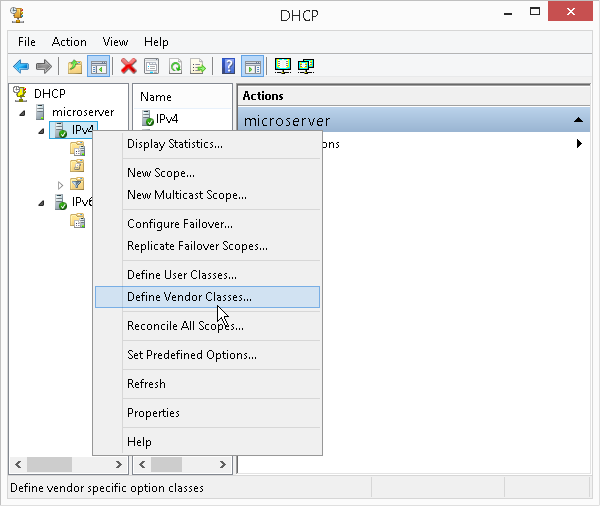
-
Set the ASCII value to AMINOx4x:
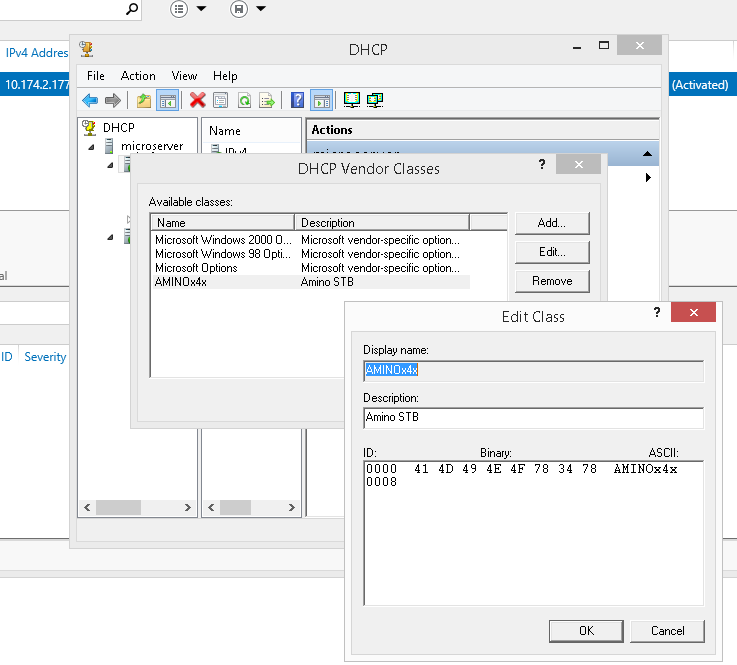 Caution
CautionThis step is very important, since this is the key the devices will lock onto. -
Create some custom predefined options against this new vendor class, as shown below:
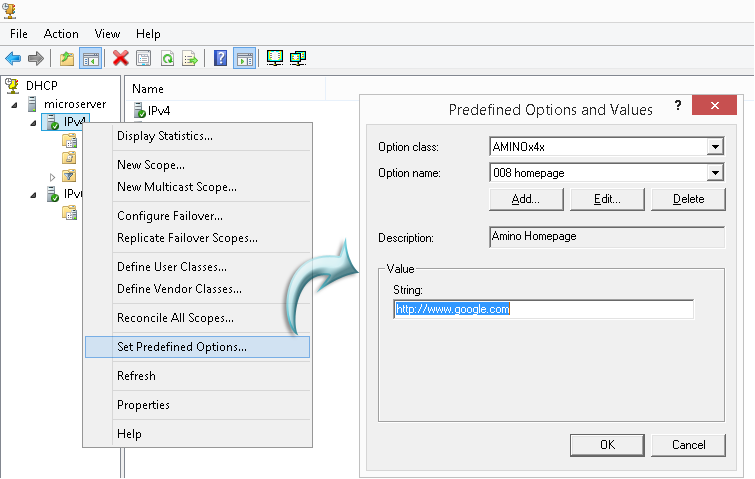
The Amino manuals show various codes available to inject here, but the four most useful ones are shown below:
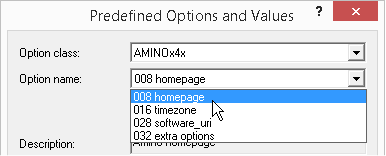
|
Important
|
For more details on the codes and their usage, please refer to the Amino website. |
Code Descriptions
The following table contains description of the four most useful codes:
| Code | Description | ||
|---|---|---|---|
008 homepage |
Defines a specific page to navigate to after booting. |
||
016 timezone |
Sets the time zone of the Amino box.
|
||
028 software_uri |
Enables you to host an MCFS firmware file and the point to it here, when there is a need to apply new firmwares. On boot, any Amino A140 will check the file and apply the update if needed.
|
||
032 extra_options |
Allows you to specify space-delimited custom options, which are used by the Cinegy Route Directory Service to attach an Amino box to a specific Cinegy Route virtual destination.
|
Code Deployment Examples
Homepage
The example of homepage URL to read the Amino control page from Cinegy Route is as follows:
http://<routeservernameorip>:9996/control/amino/amino.htmlExtra Options
The example of extra_options values is as follows:
vdestname=Desk_Amino vdestgrouppath=Amino onscreenlogging=true|
Note
|
Please note that this code is useful only when pointing the Amino box at Cinegy Route Control homepages. |
Global Scope Options
Global scope options applied to all units (so all Amino boxes get the same firmware) look as follows:
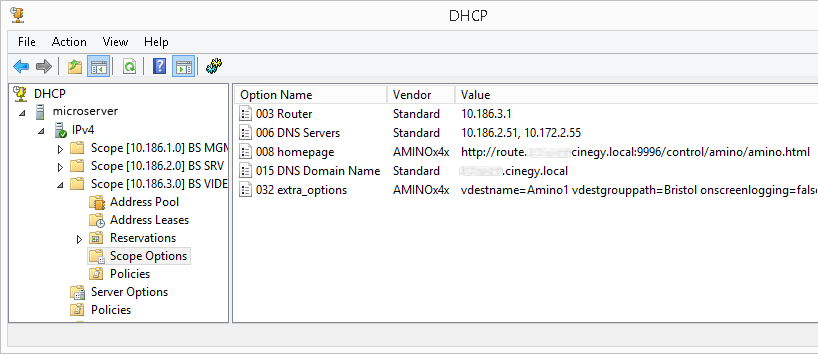
MIME Types
If using IIS to host the firmware, a MIME type registered for this is also required:
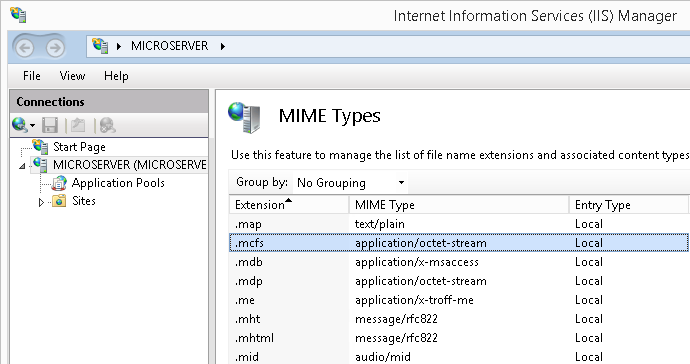
|
Note
|
Please keep in mind that HTTP server logging can be used to spy on the actions of misbehaving Amino boxes, to see what they are trying to do, and can be helpful when troubleshooting. |
Amino Box Overriding
Global settings are useful when all Amino units should share the same settings. However, it is quite likely that different units should be bound to different virtual destinations. This can either be handled by editing the control pages to register the MAC address inside the control pages (see the section on customizing the control pages later), or it can be done using DHCP reservations.
In a normal environment, using Cinegy Route – Amino integration, it is expected that each Amino box has a reservation, which tells it on boot "what" Cinegy Route virtual destination to bind to (and turns on/off on-screen logging and such).
The screenshot below displays the homepage being overridden for a specific Amino box:
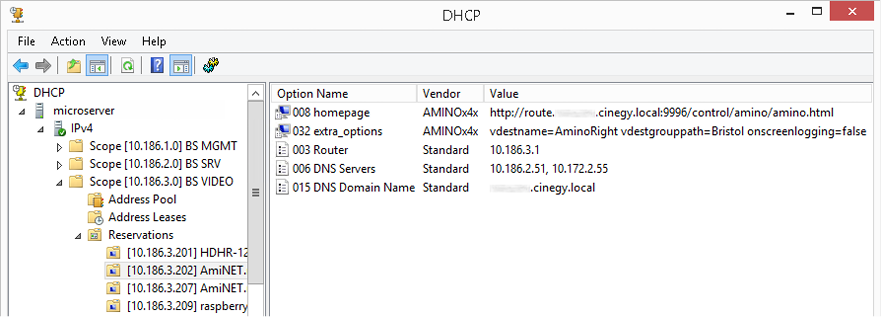
|
Note
|
You cannot mix AMINO specific options between global and reservation scope – so if make a reservation, also set any other AMINO specific options (like homepage) explicitly in the reservation. Any global options specific to the AMINO class will be ignored by the reserved unit. The above screenshot shows the homepage explicitly copied to the reservation. |